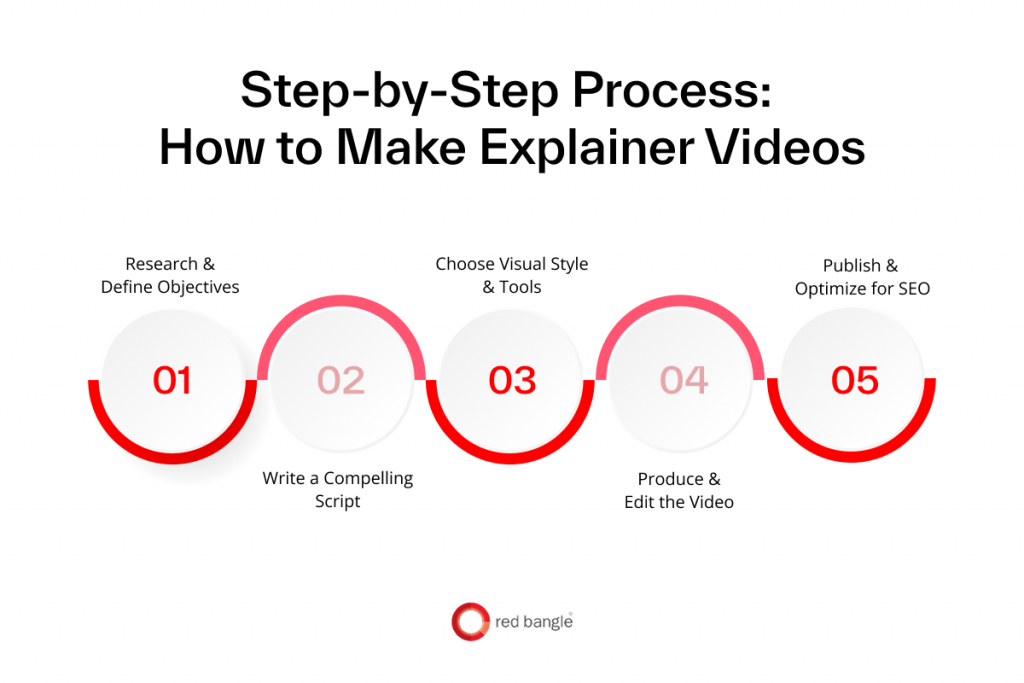How to Make Explainer Videos: A Complete 2025 Guide
Want to turn complex ideas into clear, engaging stories? This guide breaks down how to make explainer videos step by step, from scripting and visuals to tools and SEO, so you can craft videos that capture attention, build trust, and drive action.

Introduction
Some stories are so good, you don’t just hear them, you see them. That’s the magic of a great explainer video. It takes your big, brilliant idea, wraps it in visuals and sound, and delivers it in a way your audience can’t scroll past.
If you’ve ever struggled to get someone to “get” what you do, you’re not alone. We’ve all been there, talking through a product or service only to watch eyes glaze over. The problem isn’t your idea. It’s how it’s presented.
Take the Multiplier explainer we created at Red Bangle.
In just 90 seconds, it turns what could have been a jargon-heavy HR tech pitch into a snappy, crystal-clear story. The kind that makes people nod along and think, “Yep, I get it… and I want it.”
That’s not luck. It’s knowing how to guide your viewer from “Huh?” to “Aha!” without losing them along the way.
Here’s the good news. You don’t need a big studio setup or a blockbuster budget to make this happen. Stick with us and we’ll walk you through exactly how to make explainer videos that actually work. From scripting and visual styles to editing tricks and knowing when to bring in the pros, we’ve got you covered.
Why Creating an Explainer Video Matters in 2025
The way people discover, understand, and decide on products has changed and explainer videos are right in the middle of that shift. In 2025, they’re no longer an optional “extra” for your marketing; they’re the bridge between your product and your audience’s “I need this” moment.
Explainer videos simplify complexity. They take that long, winding pitch you’ve been giving and turn it into a concise, visually-driven story that clicks in seconds. Whether it’s a SaaS platform with multiple features or a new product category no one’s heard of, an explainer helps you land your message without overwhelming your viewer.
The real edge in 2025 comes from three big changes:
- AI-powered creation tools that make high-quality production possible without weeks of editing.
- Remote-first selling and onboarding where videos do the heavy lifting in place of face-to-face demos.
- Snackable content culture where short, sharp, and visually rich beats anything long-winded.
When you use an explainer video strategically, it doesn’t just “tell” your story, it makes people feel it. And that emotional clarity is what gets them to remember, trust, and act.
And it works. Research shows that 64% of B2B buyers are more likely to make a purchase after watching a video that explains a product or service clearly and concisely. This makes explainer videos not just a storytelling tool, but a revenue driver.
Let’s move on to see exactly how to make explainer videos that makes your buyers convert.
Step-by-Step Process: How to Make Explainer Videos

How to make explainer videos involves defining your goal, scripting a clear message, and selecting the right visual style.
Use animation, live-action, or screencast to match your audience and budget. Keep videos under two minutes to maximize engagement. Add a professional voice-over, consistent branding, and captions for accessibility. Optimize titles, descriptions, and thumbnails for search. Publish on platforms like YouTube, Shorts, and LinkedIn. Track watch time, click-through rates, and conversions to measure performance.
So, creating an explainer video isn’t just about hitting “record” and hoping for the best. It’s a deliberate sequence of steps that turn your raw ideas into a polished, persuasive story.
Below, we’ll walk you through the steps on how to make explainer videos that actually make people stop, watch, and remember.
1. Research & Define Objectives
Before you think about scripts or visuals, you need crystal clarity on your why and who. Without it, even the best-looking video will fall flat.
Start by defining three essentials:
- Audience Persona – Who are you speaking to? Go beyond job titles and demographics. Understand their pain points, buying triggers, and the tone that resonates with them.
- Core Message – Sum up your product’s value in one simple sentence. If viewers can repeat it after watching, you’ve nailed it.
- Call to Action – Decide the single action you want them to take: sign up, book a demo, share the video.
At Red Bangle, we’ve seen that getting these three elements right makes every creative decision easier, from script pacing to visual style. It’s the difference between a video that simply “looks nice” and one that inspires action.
As Lakshmi Rebecca, our founder, says,
“We guide clients to make the right choice for their business by helping them define their brief, their narrative, and what’s achievable within their budget and timeline. Sometimes that means recommending a testimonial or product demo instead of an explainer.”
This upfront clarity ensures every creative decision that follows is built on a solid foundation.
2. Write a Compelling Script
A great explainer video starts with a script that works on paper before it ever hits the screen. Think of it as your blueprint. It guides the visuals, pacing, and tone. At Red Bangle, we follow a storytelling approach that keeps viewers hooked from the first second to the last.
Problem–Solution–Benefit Storytelling Framework
The most effective explainers do not just describe a product. They take the viewer on a journey:
- Problem – Start by showing the challenge your audience faces in a relatable way.
- Solution – Introduce your product as the answer, highlighting how it works.
- Benefit – End with the positive outcome your viewer will experience.
When we create scripts at Red Bangle, we combine strong storytelling frameworks with hands-on collaboration between writers, directors, and storyboard artists. We align tone, pacing, and visual flow right from the first draft. Our proprietary creative cloud platform keeps every script, visual reference, and review comment in one place so nothing gets lost and every change is tracked in real time.
Our Infosys AI-First Employee Experience Explainer is an example of what makes a good explainer video.
- It opens with a relatable scenario of university staff spending hours manually searching for courses to upskill employees. The pain is clear and instantly understood.
- Then, Infosys steps in with an AI-first approach, showing exactly how their Topaz-powered solution automates the process by enabling skill- and profession-based searches.
- The benefit lands hard: search times are cut from five hours to just thirty minutes, making the impact tangible and memorable.
This structure works because it builds empathy, delivers the “aha” moment, and ends with a vision of success, all in under two minutes. Beyond structure, the most compelling scripts tell a story that connects on a human level. They do not just describe what your product does, but show how it genuinely improves the viewer’s situation.
Script Templates & Real Examples
Once you know your story arc, templates can speed up scripting without sacrificing quality. One simple formula we use often is:
- Hook – A short, engaging opener that grabs attention.
- Context – Briefly outline the problem.
- Solution – Show your product in action.
- Impact – Share the transformation it delivers.
- Call to Action – Tell viewers exactly what to do next.
Our Infosys Equinox Studio explainer uses this perfectly.
- It hooks with a bold statement about shaping composable human experiences in a no-code environment.
- The script then flows into how the platform works, covering drag-and-drop building, instant data integration, and multi-device publishing, supported by simple 2D animation and screencast visuals.
- Finally, it leaves the viewer with the clear value: faster time-to-market, seamless management, and an empowered team.
By combining clear structure with real examples, your script will guide your production team or even a DIY effort toward a focused, high-impact video.
3. Choose Visual Style & Tools
Your visual style decides how your story feels. It sets the tone, shapes audience perception, and influences how quickly your message lands. At Red Bangle, we help brands choose the style that best fits their product, audience, and budget.
Animation vs Live-Action vs Screencast
Each style has its own strengths:
- Animated Explainer – Great for abstract ideas, brand storytelling, and adding personality.
Our Infosys Extended Storefront explainer uses 2D motion graphics to show how a retail app transforms shopping in the “new normal.” Complex ideas like zero-touch journeys, curbside pickups, and analytics become easy to understand through smooth animations and visual metaphors.
- Live-Action Explainer – Ideal when you want authenticity, human connection, and context.
In our Vymo for SME Banking video, real-world scenarios are combined with subtle animation overlays. It shows a small business owner’s journey and how Vymo empowers bankers to serve customers better. The live-action footage adds emotional depth, making the solution feel more relatable.
- Screencast Explainer – Perfect for product demos and step-by-step walkthroughs.
Monday.com’s AI for Work video showcases exactly how their AI features function by showcasing the screen of the platform in action. It’s straightforward, practical, and instantly communicates value to viewers looking for functionality over fluff.
Here’s a quick comparison:
| Style | Best For | Strengths | Limitations |
| Animation | Abstract ideas, conceptual storytelling | Flexible visuals, no filming needed, easy to update | Can feel less personal if audience prefers real faces |
| Live-Action | Human connection, real-world context | Builds trust, emotional impact, relatable scenarios | Requires filming, higher production cost |
| Screencast | Product demos, tutorials | Shows real functionality, quick to produce, cost-effective | Limited visual appeal, less suited for emotional storytelling |
The right choice depends on your story. Sometimes, the best approach is even a hybrid that combines two or more styles for maximum impact.
Many creators find success by customizing scene transitions and characters instead of using generic templates straight out of the box. This ensures the visuals stay on-brand and avoid the sterile, one-size-fits-all feel.
Recommended DIY Tools & Software
If you are learning how to make explainer videos on your own, these accessible tools can help you get from script to publish without a big setup.
- Animation: Vyond or Animaker for drag-and-drop motion graphics. For deeper control, Adobe After Effects.
- Live action: Film on a recent smartphone or DSLR with good lighting. Edit in tools like Adobe Premiere Pro. For quick social cuts, CapCut.
- Screencast: Loom, ScreenFlow, or OBS Studio for clean product walkthroughs and tutorials.
- Audio polish: A USB condenser mic plus Audacity or Adobe Audition for noise cleanup and leveling.
Pick one stack and keep it simple. Your explainer video script matters more than fancy effects. Prioritize clear pacing, legible on-screen text, and clean sound. If you outgrow DIY or need complex animation, a full studio like ours can take you from creative direction to delivery across formats.
We help you identify the visual style that will best convey your story and resonate with your audience. Whether it is animation for abstract ideas, live-action for authentic storytelling, or a screencast for product clarity, our team ensures the choice aligns with your brand, budget, and communication goals.
If you’re ready to explore a collaboration, our experts can help you shape a video plan that fits your goals.
4. Produce & Edit the Video
Once your script and style are ready, it’s time to bring them to life. Production is where your planning meets execution, and editing is where the polish happens.
Voice-Over & Audio Tips
Your voice-over sets the mood and carries the narrative.
- Match tone to audience: A product aimed at enterprise clients might require a confident, authoritative delivery, while a youth-focused brand could work better with an upbeat, conversational tone.
- Control pacing: Speak at a natural, steady rhythm and allow moments of pause so visuals can breathe.
- Prioritize clarity: Use a quality microphone, record in a quiet environment, and remove background noise during editing.
- Balance with music: Choose background tracks that complement the voice, not overpower it.
The goal is to ensure that every word lands clearly, guiding viewers seamlessly through the story.
Visual Clarity & Branding
Strong visuals make your message easier to absorb.
- Follow brand guidelines: Stick to your brand’s colors, typography, and design language.
- Keep frames clean: Avoid overcrowding with too many elements on screen at once.
- Maintain high resolution: Low-quality footage or graphics reduce professionalism and trust.
- Use visual hierarchy: Make the most important elements stand out with size, placement, or contrast.
Every frame should serve a purpose, whether that’s to highlight a feature, explain a process, or create an emotional connection, while reinforcing a consistent brand identity.
5. Publish & Optimize for SEO
Publishing your explainer video is only half the job. Optimizing it ensures that it’s discoverable, accessible, and primed to perform across platforms.
Metadata: Titles, Descriptions, Tags, Thumbnails
Metadata is the behind-the-scenes information that helps search engines and social platforms understand your video. Done right, it boosts discoverability and click-through rates.
- Title: Keep it clear, concise, and keyword-rich without sounding robotic. Make sure it reflects the core benefit of your video.
- Description: Use the first two lines to grab attention. Briefly explain the problem your video solves and naturally include primary and secondary keywords.
- Tags: Add relevant keywords and phrases viewers might search for, covering variations of your product name, features, and industry.
- Thumbnail: Create a visually strong image that represents your video’s content. Avoid generic stills and instead design a thumbnail that works at both large and small sizes.
The right metadata helps your explainer stand out in a crowded search result, driving more qualified viewers to click and watch.
Optimizing these details can pay off. 21% of marketers say short-form videos deliver the highest ROI, making them the top-performing content format in 2025. A well-optimized explainer not only gets found, but also delivers measurable returns.
Accessibility: Captions & Transcripts
Accessibility makes your video inclusive while also improving SEO.
- Captions: Add accurate, well-timed captions so viewers can follow along even with the sound off. Many people watch videos in muted environments, especially on mobile.
- Transcripts: Provide a full text version of your video’s narration and dialogue. This helps search engines index your content more effectively and allows users to scan the information quickly.
- Language options: If you serve global audiences, offer captions in multiple languages to extend reach and engagement.
- Readability: Keep captions clear, avoid jargon, and ensure they don’t block important visual elements.
An accessible video not only reaches more people but also sends positive quality signals to search algorithms, improving discoverability.
At Red Bangle, we also help clients adapt their explainer videos for multiple platforms and audiences. That might mean cutting shorter social-friendly versions, localizing captions and voice-overs for different markets, or creating fresh thumbnails and promo assets.
Because all project files and versions are stored on our creative cloud platform, you can revisit and repurpose your video months later without starting from scratch.
6. When to Consider Hiring an Agency
There are times when managing a B2B explainer video entirely in-house just isn’t the best move. That’s when partnering with an agency like Red Bangle can save you time, effort, and headaches while delivering high-quality results.
You should consider partnering with a production agency when:
- You need a video done fast and done right: Agencies already have processes, crew, and creative talent in place, so you’re not starting from scratch.
- You want consistency across formats and geographies: Whether it’s an explainer for your homepage, a product launch film, or a series of customer stories, an agency ensures your brand voice stays intact, even if shoots happen in different parts of the world.
- Your team doesn’t have the bandwidth: Juggling scripting, shooting, editing, and managing multiple stakeholders can overwhelm an in-house team.
- You want end-to-end production without the headache: From pre-production planning to final delivery, agencies handle the logistics, deadlines, and quality control.
For businesses in these situations, partnering with Red Bangle means gaining a production partner who can deliver quality, speed, and consistency without adding pressure to your team.
Our process-driven workflows, powered by our proprietary creative cloud platform, keep every stage organised, transparent, and efficient. You get clear communication, proactive tracking, and quick turnarounds, all while ensuring the creative stays sharp and on-brand across every format and market.
For example, when Infosys needed to explain their Adobe eDAM Solution for one of the world’s largest chocolate retailers, they turned to Red Bangle.
We scripted, storyboarded, designed, and delivered a 2D explainer that brought their solution to life, making a complex product easy to understand, visually engaging, and memorable. That’s the power of having a dedicated production partner: speed, clarity, and creativity in one package.
Key Elements of a Successful Explainer Video
The best explainer videos aren’t about cramming in every detail. It’s about delivering one clear, compelling message in a format viewers can quickly absorb and act on. Here’s what to focus on:
- Short and focused
Aim for 60–120 seconds. Keep only what’s essential and cut the rest. Every second should move the story forward.
Wistia’s 2025 State of Video Report found that videos under two minutes see the highest engagement rates across platforms, making brevity one of the biggest levers you can pull for impact.
- Clear narrative structure
Follow a logical sequence: introduce the problem, present the solution, explain how it works, and end with what happens next. This helps viewers stay engaged from start to finish.
- Strong call-to-action
End with one specific action you want your audience to take, whether that’s signing up, booking a call, or exploring a product page. Make it easy to follow through.
- High-quality visuals and audio
Invest in professional visuals, sound design, and voice-over. A polished look and sound build trust and make your message more memorable.
When these elements align, your explainer video not only captures attention but also inspires viewers to take the next step.
Conclusion & Key Takeaways
A great explainer video doesn’t happen by chance. It’s the result of clear objectives, thoughtful storytelling, and precise execution. By keeping your message focused, your visuals polished, and your call-to-action strong, you can turn complex ideas into something your audience understands and remembers.
Here’s how to make explainer videos at a glance:
- Define your objective and audience
- Craft a concise, engaging script
- Plan visuals that reinforce your story
- Use professional production for audio and video
- End with a strong, clear CTA
- Distribute strategically for maximum impact
If your goal is to cut through the noise and connect with your audience, now is the time to start. Your product story deserves more than to sit on a page. It deserves to be seen, heard, and remembered.
Let our team help you create an explainer video that does exactly that.
Book a call with Red Bangle today and see how our process-driven approach, global creative network, and proprietary platform can turn your story into a clear, compelling video that works across every channel.



